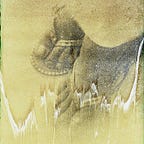70 Years after the Atomic Bomb was Dropped on Nagasaki
Growing up, I knew that my mother was from a town near Nagasaki. I don’t remember when the knowledge of this fact crossed with awareness of the atomic bombs dropped on Hiroshima and Nagasaki in August 1945.
My mother didn’t like to talk much of the war years. She preferred to talk about how she was the fastest runner at her elementary school and of the races she won. I remember once or twice she briefly mentioned that as a teenager during the war, she was drafted to be an inspector of steel plates destined for warships. As my father elaborated, “She at one time had a photo of herself with 3 or 4 other girls posing in front of a large steel plate with chalk marks indicating the flaws. I don’t know what happened to the photo — she probably destroyed it. She tended to prefer not to be reminded of those times.”
As a kid, I read about Nagasaki in the encyclopedia, how it was home to a large shipyard. I assumed that’s where my mother worked and that’s why Nagasaki was targeted. Strangely, I never wondered how my mother escaped the bomb, so that she could continue her life and later marry an American sailor deployed out of nearby Sasebo, who she met during the Korean War.
It wasn’t until yesterday, after reading this article in the New Yorker, that I asked that question to my father, Where was my mother when the bomb dropped? He told me that he assumed she was working at her inspector job in Yawata. Yawata, not Nagasaki. From the New Yorker article:
When Bockscar arrived over Kokura, at 10:45 A.M., the crew found that the arsenal was “obscured by heavy ground haze and smoke,” according to the weaponeer’s flight log. Over the years, three explanations for this change of fortune have been offered. One is that the weather turned. Another is that the smoke came from the American firebombing, the day before, of the adjacent city of Yawata (a nice bit of irony, if true). The third possibility, as has been claimed in recent years by several former technicians at a major electrical power station in Kokura, is that the haze was an intentional release of steam, created as a matter of routine when the first B-29, the Enola Gay, was spotted. For whichever reason, if not all three simultaneously, the visual bombing of Kokura couldn’t be managed. After forty-five minutes, and with anti-aircraft fire headed their way, the crew decided to try for the secondary target: Nagasaki.
At the same time I learned my mother was 100 miles from the bomb blast at Nagasaki, I learned she was working adjacent to the primary target, Kokura. She may have been spared the effects of the blast and radiation by pure good fortune, that then became the grave misfortune of others.
I think of my daughter, who was very close to my mother, and the chain of chance events, including surviving a few brushes with death of my own, that allowed her to even come into being. It’s something to contemplate but not to make sense of. The only thing I know right at this moment is I miss my mother.
